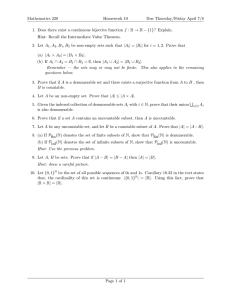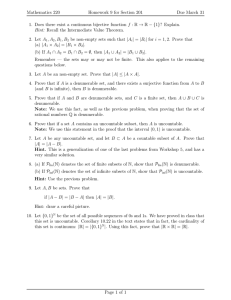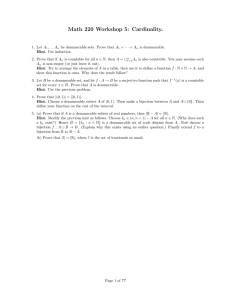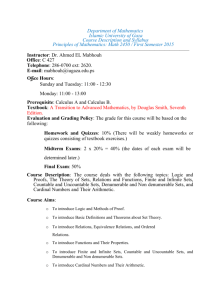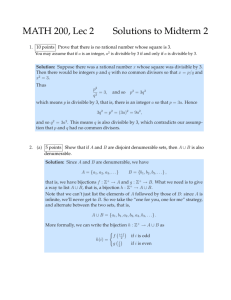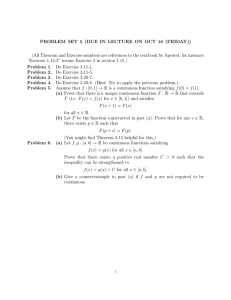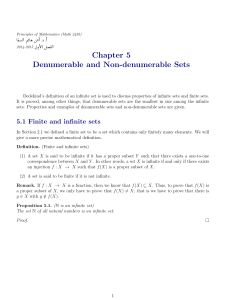Integration Chapter 4
advertisement
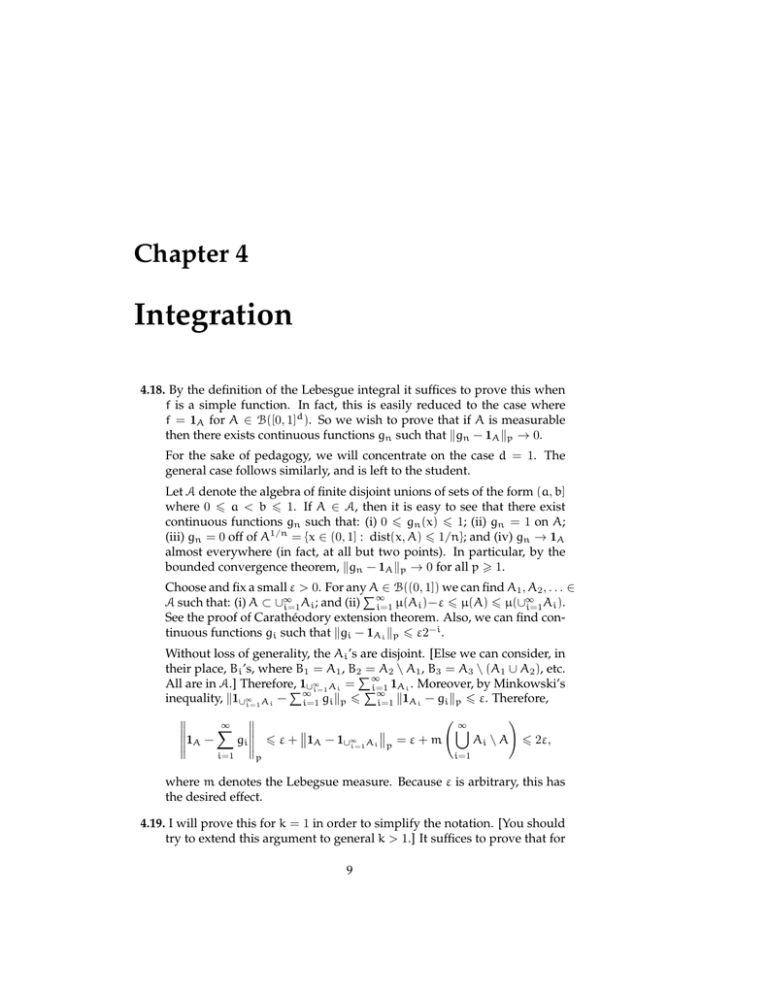
Chapter 4
Integration
4.18. By the definition of the Lebesgue integral it suffices to prove this when
f is a simple function. In fact, this is easily reduced to the case where
f = 1A for A ∈ B([0, 1]d ). So we wish to prove that if A is measurable
then there exists continuous functions gn such that �gn − 1A �p → 0.
For the sake of pedagogy, we will concentrate on the case d = 1. The
general case follows similarly, and is left to the student.
Let A denote the algebra of finite disjoint unions of sets of the form (a, b]
where 0 � a < b � 1. If A ∈ A, then it is easy to see that there exist
continuous functions gn such that: (i) 0 � gn (x) � 1; (ii) gn = 1 on A;
(iii) gn = 0 off of A1/n = {x ∈ (0, 1] : dist(x, A) � 1/n}; and (iv) gn → 1A
almost everywhere (in fact, at all but two points). In particular, by the
bounded convergence theorem, �gn − 1A �p → 0 for all p � 1.
Choose and fix a small ε > 0. For any�
A ∈ B((0, 1]) we can find A1 , A2 , . . . ∈
∞
∞
A such that: (i) A ⊂ ∪∞
A
;
and
(ii)
i=1 µ(Ai )−ε � µ(A) � µ(∪i=1 Ai ).
i=1 i
See the proof of Carathéodory extension theorem. Also, we can find continuous functions gi such that �gi − 1Ai �p � ε2−i .
Without loss of generality, the Ai ’s are disjoint. [Else we can consider, in
their place, Bi ’s, where B1 = A1 , B2�= A2 \ A1 , B3 = A3 \ (A1 ∪ A2 ), etc.
∞
∞
All are in A.] Therefore,
1Ai . Moreover, by Minkowski’s
�1∞∪i=1 Ai = �i=1
inequality, �1∪∞
− i=1 gi �p � ∞
i=1 �1Ai − gi �p � ε. Therefore,
i=1 Ai
�
�
�∞
�
∞
�
�
�
�
�
�
�
�
gi � � ε + �1A − 1∪∞i=1 Ai �p = ε + m
Ai \ A � 2ε,
� 1A −
�
�
i=1
i=1
p
where m denotes the Lebegsue measure. Because ε is arbitrary, this has
the desired effect.
4.19. I will prove this for k = 1 in order to simplify the notation. [You should
try to extend this argument to general k > 1.] It suffices to prove that for
9
10
CHAPTER 4. INTEGRATION
all N > 1,
lim
�N
ε↓0 −N
(4.1)
|f(x + ε) − f(x)|p dx = 0.
Indeed, the fact that |a + b|p � 2p (|a|p + |b|p ) for all p ∈ (1 , ∞) and
a, b ∈ R implies that
�
|f(x + ε) − f(x)|p dx
[−N,N]c
�
(|f(x + ε)|p + |f(x)|p ) dx
� 2p
[−N,N]c
�
� 2p+1
|f(y)|p dy uniformly for ε ∈ (0 , 1).
[−N+1,N−1]c
Therefore, (1.1) would imply that
�
�∞
p
p+1
|f(x + ε) − f(x)| dx � 2
lim sup
ε↓0
|f(y)|p dy
[−N+1,N−1]c
−∞
for all N > 1. Let N ↑ ∞ and appeal to the monotone convergence theorem to deduce the result from (1.1).
Now, (1.1) is trivial when f is continuous, because
�N
|f(x + ε) − f(x)|p dx � 2N sup |f(x + ε) − f(x)|p .
−N
−N�x�N
This proves the result in the case that f is continuous.
In the general case we approximate f in Lp (Rk ) by a continuous
�∞ one: For
every η > 0 there exist a continuous function fη such that −∞ |f(x) −
fη (x)|p dx � η [this follows, for instance, from Lusin’s theorem in your
real analysis course]. Therefore,
�∞
�∞
|f(x + ε) − f(x)|p dx � 2p+1 η +
|fη (x + ε) − fη (x)|p dx.
−∞
−∞
The right-most term vanishes in the limit as ε → 0. The result follows
since η is arbitrary.
4.20. For all r > 0, 1 − r � e−r . Therefore,
�
�n
x2
2
1−
� e−x /2 ,
2n
for all n, and the left-hand side also converges to the right-hand side as
n → ∞. Therefore, by the dominated
convergence theorem the integral
�∞
of the problem converges to −∞ exp(−x2 /2) dx. It remains to compute
the integral. Here is one way:
�n
�n
� √n �
� �
√ �1 n
√ 1
x2
y2
1
−
dx
=
2
n
1
−
dy
=
2n
x (1−x)−1/2 dx.
√
2n
2
− n
0
1/2
11
Evidently,
√
n
� 1/2
n
x (1 − x)
−1/2
0
Thus,
dx �
√
−n
n2
� 1/2
0
(1 − x)−1/2 dx → 0.
�n
� √n �
√ �1 n
x2
1
−
dx
∼
2n x (1 − x)−1/2 dx
√
2n
− n
0
√ Γ (n + 1)Γ (1/2)
= 2n
Γ (n + 32 )
√
nn+(1/2) e−n β
∼ 2nπ
(n + 12 )n+1 e−n−(1/2) β
√
→ 2π.
4.30. Let f(x) = eξx ; f is convex because f �� (x) = ξ2 eξx � 0. Therefore, for all
λ ∈ [0, 1] and a, b ∈ R,
eξλa+ξ(1−λ)b � λeξa + (1 − λ)eξb .
Choose and fix some x ∈ [−c, c], and define a = −c, b = c, and λ =
(c − x)/(2c) to obtain the hint’s inequality. In particular, with probability
one,
�
�
�
�
c+X
c−X
eξX � eξc
+ e−ξc
.
2c
2c
Take expectations—and recall that EX = 0—to deduce that E[eξX ] �
cosh(ξc). We claim that for all z ∈ R,
cosh(z) � ez
2
/2
(4.2)
.
If so, then E[eξX ] � eξ c /2 as asserted. The same holds if we replace X
by −X. Because of the elementary inequality e|z| � ez + e−z —valid for
2
all z ∈ R—we have E[eξ|X| ] � 2ez /2 , whence the exercise. It remains to
prove (1.2). Choose and fix some z ∈ R. By Taylor expansions,
2 2
cosh(z) = 1 +
∞
� z2j
z2 z4 z6
+
+
+ ··· =
,
2
4!
6!
(2j)!
j=0
whereas
ez
2
/2
=1+
∞
� z2j
z2
z4
z6
+
+
+ ··· =
.
2
4 · 2! 8 · 3!
2j · j!
j=0
Because (2j)! = j! · (j + 1) · (j + 2) · · · (2j) � j! · 2 · 2 · · · 2 = 2j j! (j � 1), (1.2)
follows. The second part follows from the first, and the simple inequality,
eξ|X| � eξX + e−ξX .
12
CHAPTER 4. INTEGRATION
Chapter 5
Product Spaces
5.1.
1. By definition, F is closed under complementation, denumerable unions,
and denumerable intersections.
2. Because ∅ is denumerable, P(∅) = 0. If A is denumerable, then Ac
is uncountable. Therefore, P(Ac ) = 1 = 1 − P(A). If A1 , A2 , . . . ∈ F
are disjoint, then we can divide them into two groups: Let D be the
collection of all i � 1 such that Ai is denumerable; U := N \ D denotes the indices i for which Ai is uncountable. Then, P(∪∞
i=1 Ai ) =
P(∪i∈D Ai ) + P(∪i∈U Ai ). Now ∪i∈D Ai is denumerable by Cantor’s
axiom of denumerable choice. Therefore, it has probability zero. On
the other hand, ∪i∈U Ai is uncountable and has measure one. There∞
fore, P(∪∞
i=1 Ai ) = 1 if U �= ∅ and
�P(∪i=1 Ai ) = 0 if U = ∅. It remains to prove that if U �= ∅ then i∈U P(Ai ) = 1. Suppose U �= ∅.
Then it suffices to prove that U has one element only. Suppose it has
at least two elements i and j. Because Ai and Aj are disjoint, then
Ai ⊂ Acj . But this would be a contradiction because Ai is uncountable and Acj is denumerable.
3. Let Ω be all non-negative ordinals; c the power of the continuum;
S := {x ∈ Ω : x � c}; and E := {(x, y) ∈ S × S : x < y}. As in
Example 5.10, define, for all x, y ∈ S, Ex := {b ∈ S : (x, b) ∈ E} and
y E := {a ∈ S : (a, y) ∈ E}. Then Ex is denumerable, whereas y E is
uncountable.
5.2. For simplicity consider the case n = 1. Choose and fix a positive integer k.
Let Ii,k denote the half-open interval (i/k, (i + 1)/k]. Note that Ii,k × Ii,k
is a disjoint cover of the diagonal D. Therefore,
(µ × µ)(D) �
∞
�
i=−∞
(µ × µ)(Ii,k × Ii,k ) =
13
∞
�
i=−∞
(µ(Ii,k ))2 .
14
CHAPTER 5. PRODUCT SPACES
�∞
On the other hand, µ(R) =
i=−∞ µ(Ii,k ). Because µ does not charge
singletons, limk→∞ µ(Ii,k ) = 0 for every fixed i. Therefore, the dominated
convergence theorem implies that (µ × µ)(D) = 0.
5.7. By symmetry, if the integrals each converge then
�1 �1
0
�1 �1
f dx dy = −
0
0
f dy dx.
0
So it suffices to consider one of the two double-integrals, and show that
it exists and is non-zero.
Fix y ∈ [0, 1], and note that
�1
0
f dx =
1
y2
�1
0
(x/y)2 − 1
1
dx =
((x/y)2 + 1)2
y
� 1/y
0
w2 − 1
dw
(w2 + 1)2
(w = x/y).
But it is easy to see that
�
−w
1 + w2
��
=
w2 − 1
.
(1 + w2 )2
�1
Therefore, 0 f(x , y) dx = −(1 + y2 )−1 . Integrate once more to find that
�1 �1
�1 �1
�1 �1
0 0 f dx dy = −π/4. Thus, 0 0 f dy dx = (π/4) �= −(π/4) = 0 0 f dx dy.
�1
�1 �1
5.8. For all y �= 0 −1 f(x , y) dx = 0 by symmetry. Therefore, −1 −1 f dx dy =
�1 �1
0. Similarly, −1 −1 f dy dx = 0. On the other hand, by Fubini–Tonelli
for positive functions,
�1 �1
−1 −1
|xy|
dx dy = 4
(x2 + y2 )2
�2
�1 �1
y
0
�1
0
= ∞.
y
0
�1
x
dx dy
(x2 + y2 )2
y2
dz
dy
z2
